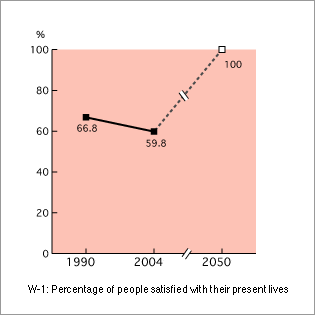ProjectsPast and current JFS projects
Indicators - Wellbeing / Life Satisfaction
W-1. Percentage of People Satisfied With Their Present Lives
1.Current Values59.8% (2004)
2.Current Points
(out of a perfect score of 100 by 2050) 60 points
Calculation method:
(Current value - minimum value) / (2050 target value - minimum value) x 100
3. Explanation of Indicator
In a sustainable society, not only are its members living within the limits of what the natural environment allows, another goal is to have more of its members realize an even higher quality of life (pursuit of the greatest happiness for the greatest number). In the fifty years since the war, Japan has experienced an extraordinary economic recovery, but this has come at the expense of spiritual richness for many of its citizens. We would like for each and every person to feel a richness of spirit in the 21st century.
As the indicator for the extent of life satisfaction, we have used the percentage of people who answered, "I am satisfied" or "I am more or less satisfied" when, as part of a "Public Opinion Survey on Citizens' Lives ," they were asked the question, "Overall, how satisfied are you with your present life?"
4.Target for 2050
Approaching 100%
5.Ideal for the Future
Approaching 100%
6. Rationale for Ideal and Target Values
There may be no such thing, at the country level, as everyone actually being satisfied, but in keeping with the spirit of "the greatest happiness for the greatest number", we have set "approaching 100%" as the ideal, as well as for the target value.
7. Source
The Cabinet Office, "Public Opinion Survey on Citizens' Lives "(Japanese only)
8. Notes
7.2% were "satisfied". 52.6% were "more or less satisfied". Starting in 2000 the questions changed slightly. There are related surveys using qualitative data. The Economist links quantitative data to a quality of life ranking by country. there i
http://www.economist.com/media/pdf/QUALITY_OF_LIFE.pdf



